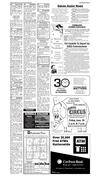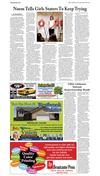060716_YKBP_A8.pdf






8 Broadcaster Press
June 7, 2016 www.broadcasteronline.com
Noem Tells Girls Staters To Keep Trying
By Shauna Marlette
shauna.marlette@plaintalk.net
For the members of the 70th
annual South Dakota Girls State
conference being held in Vermillion
this week, one great aspect of the
event is being exposed to the current leaders of both our state and
our government. It was no different
on Thursday when South Dakota
Congressional Representative Kristi
Noem spoke to the attendees.
Her message: “Never give up trying. If you fail, try again.”
Noem said that many times
when someone fails, they become
of failure rather than embracing it
as the learning and growing experience it should be.
“First of all, don’t be afraid of
failing,” she said. “I think many
times when we fail at something
or aren’t selected for something…
you will not try again. Try again.
Some of our greatest leaders failed
miserably.”
She used the example of Walt
Disney who was fired from a job
for lack of imagination and good
ideas to Henry Ford and President
Abraham Lincoln.
“If you look at Abraham Lincoln,
he went broke in business at age
21,” Noem said. “He lost a legislative race. He went broke in business
again. Then, he had a nervous
breakdown at age 27. After that he
ran for congress and lost, he ran for
the Senate and lost, then he ran on
the vice presidential ticket and lost.
He ran again for the Senate and
lost, again. Then at age 52, he was
President of the United States. We
really truly believe he was one of
the most humble, servant minded
leaders that we have ever had. So,
even though he had tried and failed
all those times, he continued to try
because he wanted to contribute.”
She added, finding a path you
want to take is great, but if you
don’t try new things you might miss
out on something fantastic.
“We all have those instances in
life where if you don’t try something new you won’t find what
you love,” Noem said. “Every new
experience that I said, ‘OK, I will
try that.’ has usually connected me
with somebody that has been very
important to my life. That is my
advice to you today,
to keep doing things
and trying new things.
Something you think
you may do or a talent
you have may not
develop as you get
older. You may find
out I am really good at
this, and it will open
new doors for your
future.”
Noem went on to
say that the attendees
of Girls State should
be proud of what they
have already accomplished.
“I want you to
know that I believe
you are leading right
where you are today,”
Noem said. “You have
so many people that
are watching you and
opportunities for you
to serve, that I don’t
want you to think
that what you are
doing today is not important. Your
generation is volunteering and serving your communities at double the
rate of my generation. 14.5 million
of you are currently involved in
volunteer activities.”
However she questioned why
they do not vote at the same rate.
“Maybe you don’t think your
generation can make a difference
when it comes to voting,” she said.
“We need to change that. But it
isn’t that you don’t care about your
communities, you prove that by the
amount of time you volunteer.”
During her visit with Girls State,
Noem explained what path her life
had taken to lead her to serving in
government.
“When I was in college my
father passed away,” she said. “We
received a letter from the Federal Government saying we owed
death taxes. There is a law that the
Federal Government that says that
everytime that someone passes
away the family has to pay taxes
on everything they owned. Well,
we were farmers so we had land,
machinery and cattle, but we didn’t
have money in the bank.”
Noem said she was confused
why the government would have a
law that would cause families suf-
• AUTOMOTIVE COLLISION REPAIR
• PAINT • FRAMEWORK
• GLASS REPLACEMENT
fering a tragedy have to pay them
money.
“It made me mad,” she said.
“The only option I really had at
that time was to take out a loan. So,
for ten years, we paid those taxes
and made payments on the loan. It
made it very hard for us to keep our
family farm together. So, I decided
that we needed more people who
were running family businesses
who lived everyday normal lives,
making our laws so they would
know what the everyday consequences were of those laws and
how they hit families.”
She added that in South Dakota,
just that one death tax can be a
catastrophe for a lot of family businesses.
“So, I decided to run for the
legislature in 2006,” she said. “I was
only there for a couple of weeks
before I realized that leadership
controls everything. They decide
what committees a bill goes to.
They can decide if they don’t like a
bill to have the committee kill it, if
they like it, it might go forward. So,
my second term I decided to run
for assistant majority leader. My
colleges of the house elected me to
that. In 2010, I decided to run for
congress and was elected to represent the state in Washington DC.”
As for what it is like in Wash-
ington, D.C. the easy
answer is very busy.
“I have a pretty
typical story for a lot
of people in South
Dakota,” Noem said.
“I get up every day
about 5:30 or 6 a.m.
I live in my office,
which most of you
might be aware of.
The first year I was in
Washington I rented
an apartment, but
it was just a little
room in a basement
of someone’s home
and it cost me nearly
$2,000 a month and
I was never there.
I would leave by 6
a.m. or 7 a.m. and I
wouldn’t get home
until 11 p.m.”
She said that she
knew that some of
the other members
of Congress were
living in their offices
and now there are probably 30 or
40 of them that do it.
“I have a couch that pulls out
into a bed right there and there is a
gym in the basement,” Noem said.
“So, I get up in the morning and go
down to the gym, do my work out
and get ready for the day. Our meetings start by 7:30 or 8 a.m.”
She also noted that it is interesting how many people from South
Dakota are in Washington each
week.
“Every Wednesday, Senators
Thune and Rounds and I have a coffee for South Dakotans that are in
town,” she said. “We give them an
update about what we are working
on and they can ask us questions.
We invite everyone who is in DC for
that week to come for coffee. We
typically have 60 and 100 people
every single week. That is how
many people are there either touring, on family vacations or working
on issues that are important to
them. My typical day is filled with
at least 10-15 different meetings
with South Dakotans and then we
have committee hearings, as well.
Usually we wrap up at about 9-10
p.m.”
Noem said that she is very
proud to be the first South Dakotan
USDA Celebrates
National
Homeownership Month
Hartington Tree LLC
TREE TRIMMING, REMOVALS & TRANSPLANTING
HOURS:
TREES FOR SALE
EVERGREEN • SHADE • ORNAMENTAL
M-F
9AM-6PM
SAT
9AM-12PM
Yankton 605-260-1490
Hartington 402-254-6710
1205 CARR STREET • VERMILLION • 605.670.0471
BlainesBodyShop@gmail.com
Serving Southeast SD & Northeast NE for 20 Years
Kent & Kyle Hochstein • Licensed Arborists
www.hartingtontree.com
Your New Home At... Westbrook
Estates
Located On West City Limits Road
2508 Wynn Way • $164,800
900 sq. ft. on main, 2 bedrooms, 1 bath, laundry in lower level, 2 stall garage, appliances included.
Lots Available From $24,900-$26,900
Additional Homes Available $164,800-$198,800
Additional Floor Plans Coming Soon!
ankton Area Progressive Growth
Economic Development
416 Broadway • Yankton, SD • 664-5555
Lisa Williams
Randy
Kussman
Stacy
Schramm
Norene
Gibson
Deb
Specht
to serve on the Ways and Means
Committee.
“About a year and a half ago,
I was appointed to the Ways and
Means Committee,” she said.
“Somebody told me when I was
working to get on this committee
that it was the committee that had
the most ways to be mean because
it has jurisdiction over taxes, trade,
social security, Medicare, entitlement programs and all of our foster
care programs go through there.
About 80 percent of what we are doing in the House goes through the
Ways and Means Committee and I
decided that I was going to work to
get on that committee because if a
lot of the legislation that we signed
in to law was going to be completed
in that committee, I wanted to make
sure that someone that came from
a rural state like South Dakota was
weighing in on the issues.”
She also noted that one of the
things she most enjoys serving
the state is voting in the House
Chambers.
“Because there are 100 senators
in the Senate, they vote by voice,”
Noem explained. “They call their
name and they vote yes or no audibly, because there are 435 members
of the House we can’t do that. We
vote by electronic machine. If you
look at the House floor the décor is
all beautiful woodwork and historic
wallpaper. When it comes time to
vote they turn on the voting machine and all of a sudden above the
speakers head it shows all of our
names, all 435 of us.”
She said the system tallies and
keeps track how the vote is going: if
it is passing or failing.
“All of it lights up like a huge billboard and we start to vote,” Noem
said. “When the vote is over it tells
us exactly how everyone voted and
if the bill passed or failed. Then
they shut the machine off and the
chambers look exactly how they
would have looked 100 years ago.
It is a really neat process for me to
be able to vote on something that
is important to South Dakota. What
is even cooler is that that whole
system was installed and built by a
South Dakota Company – Daktronics. For me it is pretty special to
vote in Washington DC and I get
to do it on something that South
Dakota enabled us to do.”
Dan
Specht
Jill
Ward
WASHINGTON – Agriculture
Secretary Tom Vilsack today
kicked off National Homeownership Month by highlighting USDA’s ongoing role to help people
buy homes in rural areas.
“Owning a home helps
promote stable communities
and is one of the best ways
American families can build
wealth,” Vilsack said. “During
the Obama Administration,
USDA has helped more than one
million rural families and individuals realize their dreams of
homeownership. This year, our
celebration of National Homeownership Month will recognize
partnerships with some of the
many organizations that have
worked with us to make this
achievement possible.”
USDA builds strong relationships with lenders, home
builders, realtors, community
development organizations,
non-profits and housing finance
authorities to provide homeownership opportunities to
very-low, low- and moderate-income individuals in rural areas.
USDA’s Guaranteed Loan
program, for instance, increases
access to mortgage financing in
rural communities by offering
approved lenders a 90 percent
loan guarantee to offset their
risk if a borrower defaults.
By partnering with approved
public and private lenders,
more than one million low- to
moderate-income families have
bought and refinanced homes
in rural America through this
program during the Obama
Administration. The program
requires no down payment from
the applicant, offers a fixed
interest rate, and has a 30-year
loan term.
The Department recently
announced a series of changes
that will make it faster and
cheaper for rural homeowners
with USDA-backed mortgages to
refinance their loans and save
money with a lower interest
rate. The changes take effect
June 2. Interested homeowners with USDA loan guarantees
should contact their lender
about refinance procedures.
Homeowners with mortgages
through USDA’s Direct Loan
program should contact a USDA
housing specialist.
In addition to mortgage
financing, USDA provides
grants and loans to help rural
homeowners make improvements or repairs, such as
removing health and safety
hazards or making accessibility
modifications for people with
disabilities.
USDA has invested more
than $137 billion since 2009 to
support rural homeownership.
In 2015 alone, the Department
invested $19.5 billion to help
more than 148,500 rural families
buy or make repairs and safety
upgrades to their homes. USDA
created more homeownership
opportunities through seven
years of the Obama Administration than during any previous seven-year period in the
single-family housing program’s
history.
USDA employees will celebrate National Homeownership
Month throughout June with
events across the nation that
demonstrate the commitment
to provide access to affordable
housing for low- and moderateincome rural residents. To learn
more about USDA’s observance
of National Homeownership
Month, please visit our Facebook page or contact a Rural
Development State Office near
you.
USDA Rural Development (@
usdaRD) has helped 1.1 million
rural residents buy homes
since 2009; funded nearly
7,000 community facilities
such as schools, public safety
and health care facilities; and
invested $31.3 billion in 963
electric projects that have financed more than 185,000 miles
of transmission and distribution lines serving 4.6 million
rural residents. USDA also has
invested $11 billion to start or
expand 103,000 rural businesses; and helped bring high-speed
Internet access to nearly 6
million rural residents and businesses. For more information,
visit www.usda.gov/results.















 Previous Page
Previous Page





